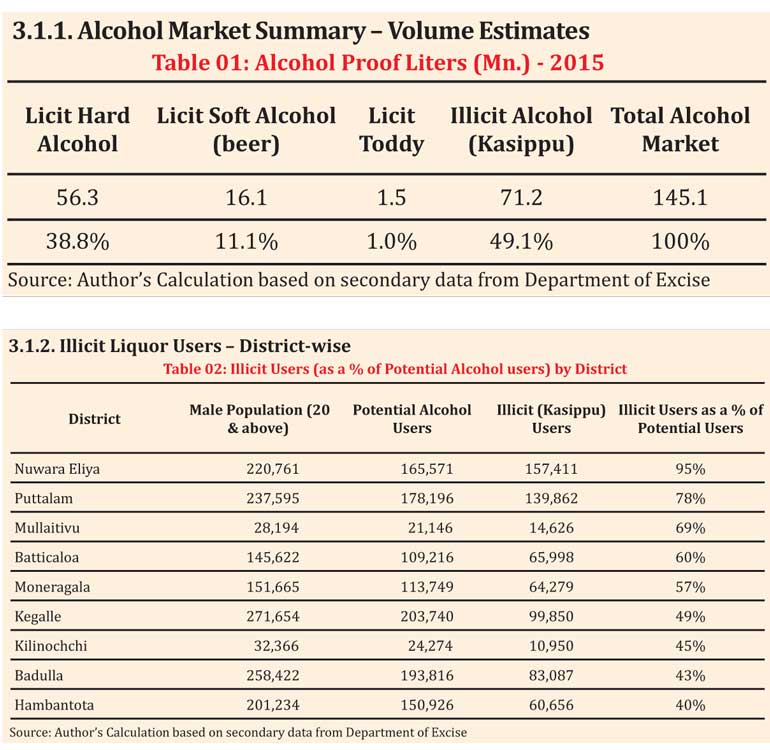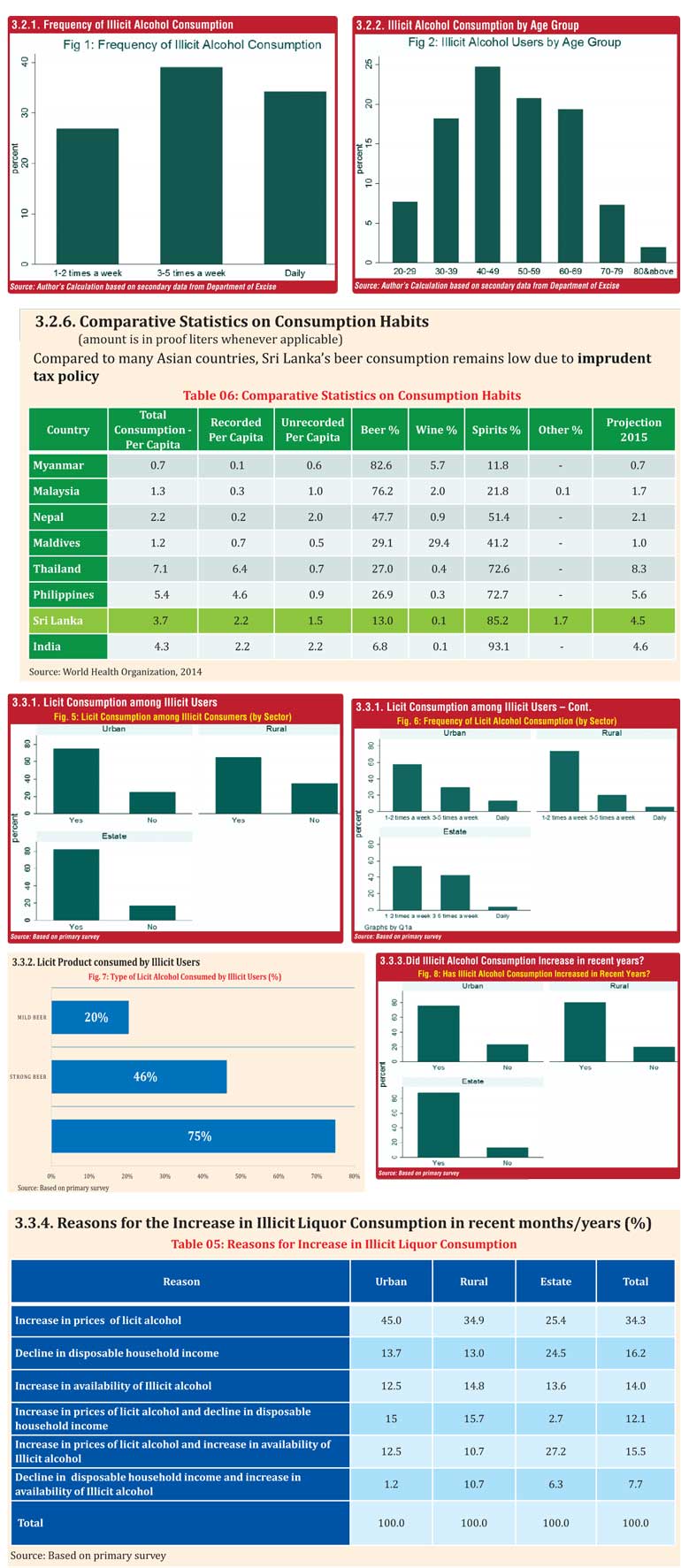

By Priyanga Dunusinghe,
1. Introduction
1.1. Overview
The illicit alcohol poses a substantial health, economic and social costs to the society in general and in particular to the users. In addition, it causes loss of Government of revenue and incur additional health costs.
It is important that policy makers to have a clear picture on the relative size, geographical distribution, consumption habits, and health and economic costs of illicit alcohol industry. Such information is immensely useful in decision making.
Moreover, it is equally useful to make general public aware on the health, social and economic consequences of consuming illicit alcohol since availability of such information, in combination with other policies such as government tax policy on licit alcohol, to general public may decline the illicit liquor consumption in the long-run.
1.2. Research objectives
- Estimate the size of the market by volume and value
- Examine recent trends in illicit alcohol consumption
- Discuss the health, economic, and social costs of the illicit industry
- Trends in illicit alcohol detections
2. Research design
2.1. Methodology and data
Illicit alcohol market
- Share of ‘illicit alcohol using households’ derived from the HIES (Household Income & Expenditure Surveys – 2006/7; 2009/10, and 2012/13) for each economic sector; Urban, Rural, and Estate
- Introduced an ‘adjustment factor’ based on expert opinion and previous literature to rectify the under-reporting of illicit alcohol consumption
- Multiply the estimated shares by respective potential alcohol users by sectors for each district
- The total number of illicit alcohol users were weighted by the district poor population, informal labour force, and labour force in the agriculture
- Cross-examined the proportion of arrested with the police records on illicit liquor detection and previous literature
3. Key findings
3.1. Alcohol market in
Sri Lanka
- Illicit alcohol accounts for 49% of the total alcohol market
- There are around 1.35 m illicit alcohol users in the country
- Around 203 m (bulk) litres of illicit alcohol consumed per year; this number is equal to 71 m proof litres (assuming alcohol content in kasippu to be 20%)
- Total market size is estimated to be Rs. 108 b per year, assuming Rs. 400 per bottle (0.75 bulk litre)
- Nuwara Eliya, Puttalam, Kegalle, Moneragala, Badulla, Kilinochchi are some of the heavily illicit using districts. Alcohol market in those districts heavily dominated by illicit alcohol
- Illicit alcohol per capita consumption for potential alcohol users remains around 14 proof litres per year However, per capita consumption of illicit user is around 53 proof litres per year
- Per capita consumption of illicit alcohol is higher in districts such as Nuwara Eliya, Puttalam, Badulla, Moneragala

3.2 Consumption patterns
- Around one-third of total illicit users are daily consumers while closer to 40% of illicit users consume three to five days a week
- The above indicate over 75% of illicit users are heavy drinkers
- It implies that they incur significant socio-economic and heath costs to the household and the community
- Over one-fourth of illicit users are less than 40 years old
- There is a clear pattern that frequency of illicit consumption increases when person get older
- Policy makers need to pay greater attention in arresting these situations
3.3. Trends in illicit alcohol consumption in recent years
- The majority of illicit users (71%) also consume licit alcohols indicating that they continue to consume illicit due to lack of resources to finance licit alcohols and/or accessibility issues
- Or the frequency of licit use, among illicit users, declined in recent years
- Illicit users mostly consume licit spirit (75%) followed by licit strong beer (45%)
- Sample survey and key informant discussions revealed that illicit alcohol consumption shot up around 30-40% in recent years
- An increase in illicit alcohol is prominent in rural areas
- Recent increase in prices of licit alcohol is highlighted as the prime reason for the increase in illicit consumption

3.5. Economic and
heath effect of (mostly)
spirit consumption
According to the recent research, carried out by World Health Organization in collaboration with National Authority on Tobacco and Alcohol, and Expert Committee on Tobacco, Alcohol and Illicit drugs (2017), the direct and indirect economic costs of alcohol are substantial.
WHO (2017) estimated direct and indirect costs related to a number of diseases related to the use of alcohols. It is relatively obvious that such diseases are largely caused due to the use of spirit – both licit and illicit alcohols.
While direct costs include costs of alcohol and medical related costs borne by individuals and state, the indirect costs include loss of productivity. Several research have found that use of illicit alcohols are behind the many diseases, especially in rural Sri Lanka.
These costs exceed the direct revenue obtained by the government through taxation of spirits without including additional costs such as psychosocial costs of impoverishment, diseases and premature mortality not considered. Following tables provide costs related to various diseases in details.
(The writer, PhD, Department of Economics, University of Colombo, can be reached via [email protected].)

3.5.3. Health risks of illicit liquor consumption (findings of previous studies)
- There is a strong relationship between illicit alcohol consumption and suicides (Abeyasinghe & Gunnell, 2008)
- Among Sri Lankan suicides, 48% are related to alcohol consumption (Wijesundere, Island newspaper, 4 Oct 2016)
- Frequent hospitalisation and even death due to poisoning illicit alcohol (Beligaswatte et al.; 2008)
- Long-terms damages to nerve system, eyes, and bones due to heavy use of spirit (both illicit and licit) (Ferdinandis, 2008)
- Above studies indicate, in the context of Sri Lanka, illicit alcohol consumption has been a menace to society
4. Conclusion
- According to our results, illicit alcohol accounts for 49% of the total alcohol market in Sri Lanka. This figure is comparable with estimates done by the WHO and other agencies in the past
- Nuwara Eliya, Puttalam, Kegalle, Moneragala, Badulla, Kilinochchi are some of the heavily illicit using districts. Alcohol market in those districts heavily dominated by illicit alcohol
- Illicit alcohol per capita consumption for potential alcohol users remains around 14 proof litres per year; however, per capita consumption of illicit user is around 53 proof litres per year
- Heavy alcohol consumption is predominantly prevailed among illicit users since illicit liquor is easy to access, widely available, and relatively cheaper
- Clear and overwhelming evidence to suggest that illicit alcohol consumption has increased around 30%-40% in recent years
- Recent estimates suggest that there are substantial economic and health costs due to alcohol consumption, mainly illicit and licit spirit
- Detection of illicit alcohol remains very weak suggesting it is required to have an alternative way for reducing the illicit use

Conclusion – Policy recommendation
- nIncrease in prices of licit alcohol as well as the ad-hoc (imprudent) and uneven taxation are prime reasons for the increase in demand for illicit alcohol
- n Rationalisation of prices of licit alcohol need to be considered as a policy option while it is high time for Sri Lanka to discourage, in line with other developing and developed countries, the consumption of alcohols containing high level of spirit
- n Prudent tax policy not only discourage the use of illicit alcohol, thereby reducing economic, health, social, and psychological costs, but also maximises government revenue
- n Policy makers need to conduct a comprehensive awareness on economic, social, health and psychological costs of using illicit alcohol and alcohol with higher spirit content
- n Due to a number of reasons, law enforcement remains relatively less impressive; it is required to introduce a rewarding system for law enforcement officials so as to encourage more detection.
- n It is also imperative that government study the trends in the illicit alcohol market on regular basis.







